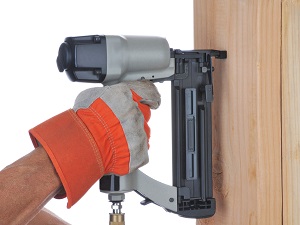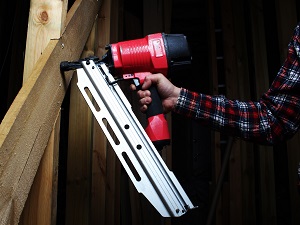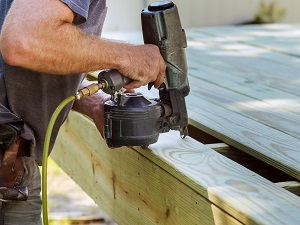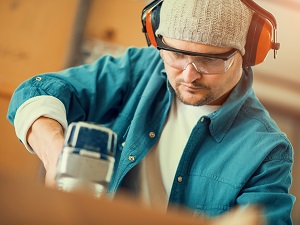Nail guns, also called nailers, are useful power tools that boost productivity on the job but also cause tens of thousands of painful injuries each year.
The majority of nail gun injuries are to the hands and fingers, but severe nail gun injuries can result in paralysis, blindness, brain damage, bone fractures, and death. Only workers who have been trained on safe operating procedures should be using nail guns.

Referring to pneumatic nailers, as well as nail guns that use gas, electric, or hybrid power sources, this article provides information on the most common nail gun hazards and safety tips that will help prevent nail gun injuries on job sites.
USEFUL TERMS
Bump Firing (or bounce nailing) is using a nail gun with a contact trigger held squeezed and bumping or bouncing the tool along the work piece to fire nails.
Double Fire occurs when a second nail unintentionally fires because the nailer re-contacted the work piece after recoil. It can also occur if the safety contact slips while the user is positioning the nail gun. Several tool manufacturers offer “anti-double fire” features for their nail guns.
Recoil is the rapid rebound or kickback after the nailer is fired. The recoil of the nail gun can even cause a non-nail injury in tight spaces if the nail gun hits the user’s head or face.

All workers using nail guns, or working near others who are using nailers, should be wearing proper PPE for protection including:
- Safety shoes, like steel-toed boots
- Hard hats
- High-impact eye protection, safety glasses or goggles marked ANSI Z87.1
- Hearing protection, like earplugs or earmuffs
OSHA Standard 1910.242(a) Each employer shall be responsible for the safe condition of tools and equipment used by employees, including tools and equipment which may be furnished by employees.
Major risk factors that can lead to a nail gun injury include:
- Unintended nail discharge from double fire or from knocking the safety contact with the trigger squeezed.
- Nail penetration through a lumber work piece, which can happen when a nail is placed near a knot in the wood.
- Nail ricochet after striking a hard surface or metal feature. Wood knots and metal framing hardware are common causes of ricochets.
- Missing the work piece which can happen when the tip of the nail gun does not make full contact with the work piece and the discharged nail becomes airborne.
- Nailing in awkward positions where the tool and its recoil are more difficult to control.
- Bypassing or disabling safety features of a nail gun.
Unintended nail discharge is more likely to lead to a hand or arm injury for placement work compared to flat work, where the lumber does not need to be held in place by hand. Examples of flat work include roofing, sheathing, and subflooring.

All nailers rely on two basic controls: a finger trigger and a contact safety tip located on the nose of the gun. Trigger mechanisms can vary based on:
- the order in which the controls are activated, and
- whether the trigger can be held in the squeezed position to discharge multiple nails OR if it must be released and then squeezed again for each individual nail.
It’s important to understand how the exact nail gun you are using works based on the kind of trigger system it has, because not all nailers work the same. Some nail guns even have a selective trigger switch which allows the user to choose among two or more trigger systems.
OSHA Standard 1926.302(b)(3) All pneumatically driven nailers, staplers, and other similar equipment provided with automatic fastener feed, which operate at more than 100 p.s.i. pressure at the tool shall have a safety device on the muzzle to prevent the tool from ejecting fasteners, unless the muzzle is in contact with the work surface.
A full sequential trigger is the safest type and will only fire a nail when the controls are activated in a certain order by pushing the safety contact first and then squeezing the trigger. Both the safety contact tip and the trigger must be released and activated again to fire a second nail. When using a nail gun with a full sequential trigger nails cannot be bump fired. A full sequential trigger reduces the risk of unintentional nail discharge and double fires—including injuries from bumping into co-workers.
At a minimum, provide full sequential trigger nailers for placement work where the lumber needs to be held in place by hand. Examples include building walls and nailing blocking, fastening studs to plates and blocks to studs, and installing trusses.

Safety precautions for workers using nail guns:
- Ensure that manufacturers’ tool labels and instructions are understood and followed.
- Check tools and power sources before operating to make sure that they are in proper working order. Take broken or malfunctioning nail guns out of service immediately.
- Set up operations so that workers are not in the line of fire from nail guns being operated.
- Check lumber surfaces before nailing. Look for knots, nails, straps, hangers, etc. that could cause recoil or ricochet.
- Use a hammer or positive placement nailer when nailing metal joinery or irregular lumber.
- For placement work, always keep hands at least 12 inches away from the nailing point. Consider using clamps to brace instead of your hands.
- Always shoot nail guns away from your body and away from co-workers.
- Set up jobs to minimize the need for nailing at height. Consider using scaffolds instead of ladders.
- Never bypass or disable nail gun safety features.
- Do not lower the nail gun from above or drag the tool by the hose.
- Do not use a nail gun with your non-dominant hand.
Consider restricting inexperienced employees to full sequential trigger nail guns starting out. Some contractors using more than one type of trigger on their jobs color-code the nail guns so that the type of trigger can be readily identified by workers and supervisors.

Encourage your workers to keep their fingers off the trigger when holding or carrying a nail gun. If this is not natural, workers should use a full sequential nail gun or set down the nailer until they begin to nail again.
When using pneumatic nailers, always disconnect the compressed air when:
- leaving a nailer unattended
- travelling up and down a ladder or stairs
- passing the nail gun to a co-worker
- clearing jammed nails
- performing any other maintenance on the nail gun
Workers should seek medical attention immediately after nail gun injuries, even for hand injuries that appear to be minimal. Materials such as nail strip glue or plastic or even clothing can get embedded in the injury and lead to infection. Barbs on the nail can cause secondary injury if the nail is removed incorrectly. Nail gun injury complications can be avoided when workers seek immediate medical care.
For more information visit OSHA's website on Nail Gun Safety or download the OSHA booklet on Nail Gun Safety.

.jpg)

